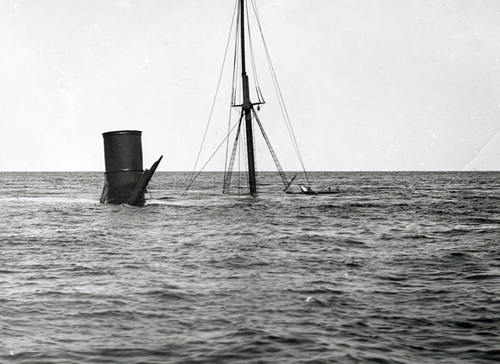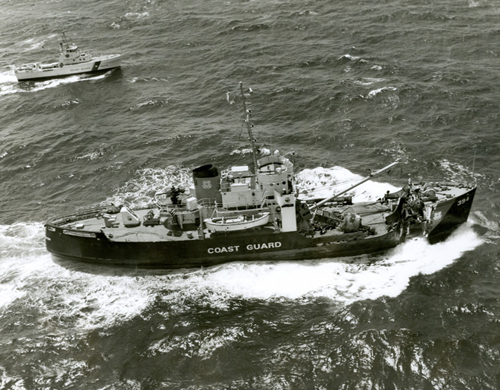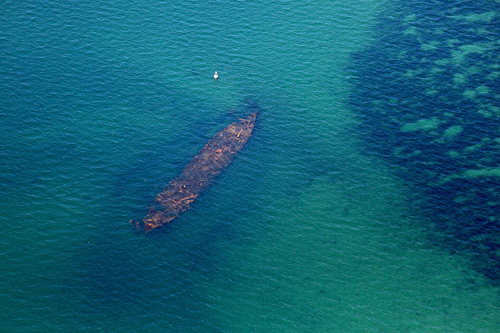Cape Cod, Martha’s Vineyard, and Nantucket are home to over 600 miles of coastline, 22 lighthouses, 350 freshwater ponds, millions of hydrangeas… and thousands of shipwrecks! Between the years 1850 and 1980, it is believed that approximately 3500 shipwrecks occurred along the Cape and Islands coastlines. During the 1800’s, there were at least two shipwrecks per month during winter. As a result, the waters surrounding the area became known as an “ocean graveyard.”

The wreck of the USS Tallapoosa
Photo courtesy of Cape Cod Travel
Prior to the construction of the Cape Cod Canal in 1914, ships carrying cargo and people were forced to navigate the treacherous waters of the Cape Cod coastline in order to get to ports along northern New England and farther north. The waters surrounding the Cape and Islands were dangerous and deadly, primarily due to the shifting sandbars, most notably from Chatham and all along the Outer Cape.

The Coast Guard Cutter, Hornbeam, collided with a freighter off Nantucket
Photo courtesy of Cape Cod Travel
As shipwrecks became such a frequent occurrence around the Cape, the Massachusetts Humane Society built huts along the most dangerous sections so that, if shipwrecked sailors were able to get to shore, they would have a place to seek shelter during the winter months. Oftentimes, sailors would make it to shore, but, with no protection from the elements, they would die from hypothermia and exposure. In 1872, lifesaving stations were erected every 5 miles along the Outer Cape’s coast. Assigned to each station would be 6 or 7 surfmen who would patrol the beaches, as well as a keeper who would remain at the station to keep a continuous lookout for shipwrecks and survivors of the wrecks.
One of the earliest recorded shipwrecks in the waters off Cape Cod was the Sparrow Hawk. The sailing vessel was headed from England to Virginia in 1626 when it hit stormy weather and shipwrecked in the area of Nauset Beach in Orleans. Due to several storms and shifting sandbars, the ship was buried within a few weeks. In 1863, similar storms that had buried the Sparrow Hawk had uncovered the hull, and many parts could be salvaged. Today the reconstructed Sparrow Hawk is on display at the Cape Cod Maritime Museum in Hyannis.
Another well-known shipwreck was that of the HMS Somerset. The English Royal Navy gunship was built in Chatham in 1748 and was involved in several battles in both the Seven Years War and the American Revolution. But the vessel met its demise in 1778 in the waters off Provincetown. The wreckage has been exposed by storms only three times since it wrecked - in 1886, 1973, and in 2010. Even though the vessel lies on the shores off Cape Cod, it is still the property of the United Kingdom.
The most notorious of all shipwrecks to occur on the shores of Cape Cod was that of the Whydah. The Whydah was an English ship traveling between Cuba and Hispaniola in February of 1717 when it was attacked by the pirate, “Black Sam” Bellamy. He and his crew took over the ship, and Bellamy made it his flagship. He sailed the Whydah along the Eastern Seaboard attacking, stealing from, and looting other ships. As it headed for the coast of Maine, however, the Whydah ran into a Nor’easter, which it succumbed to for its final resting place near Marconi Beach in Wellfleet. It is believed that the pirate ship was loaded with up to 5 tons of gold, silver, and jewelry. Today, the Whydah is an ongoing archeological shipwreck recovery project, and to date, over 200,000 artifacts, ranging from cannons, to coins and jewelry, have been recovered. Provincetown is home to Expedition Whydah, where there are exhibits, artifacts and loads of information related to the Whydah and her pirates.
Recent shipwrecks sightings took place in January of 2008 and October 2014. In 2008 parts of what was believed to be a 19th century schooner washed up onto the shores of Newcomb Hollow Beach in Wellfleet, providing visitors and residents a glimpse into Cape Cod’s rich maritime history. Most recently a sighting of the SS James Longstreet, which was a WWII cargo ship turned target ship for the US Navy. The ship was brought to Cape Cod Bay, 3.5 miles off the coast of Eastham, in 1945 and served as a target for bombs, bullets, and rockets from the Army, Navy, and Air Force until 1971. It sunk in 1996 and through the years parts of it have been seen, but only rarely, at very low tides. This year a lunar low tide allowed views of the rusted ship.

SS James Longstreet
Photo Courtesy of Christopher Seufert
Visit Cape Cod and the Islands to learn more about shipwrecks, but don’t get marooned in a hotel room - choose a spacious Cape Cod vacation rental and spend a weekend or a week exploring Whydah Pirate Museum, Nantucket Shipwreck & Lifesaving Museum, The Salt Pond Visitors Center in Eastham and wandering the many beaches of the Cape and Islands - because you never know when a storm may shift the sands and reveal an exciting piece of history!